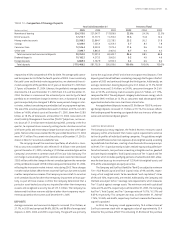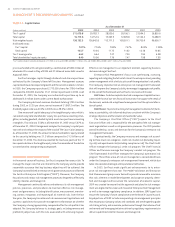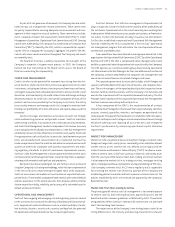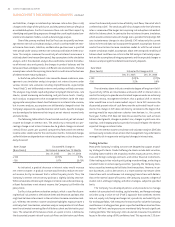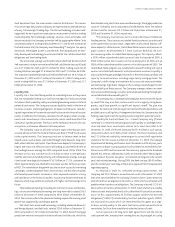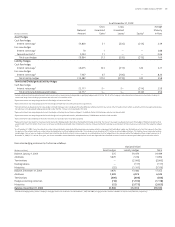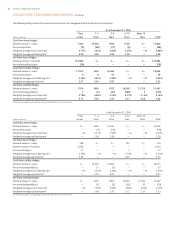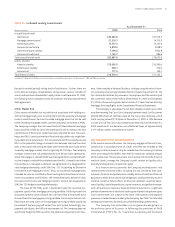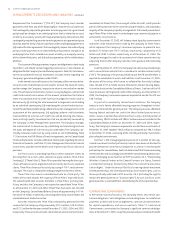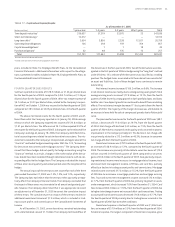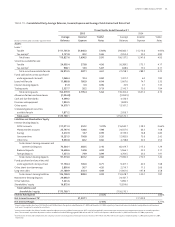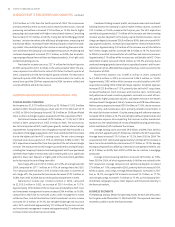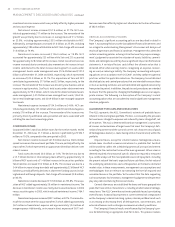SunTrust 2005 Annual Report Download - page 44
Download and view the complete annual report
Please find page 44 of the 2005 SunTrust annual report below. You can navigate through the pages in the report by either clicking on the pages listed below, or by using the keyword search tool below to find specific information within the annual report.SUNTRUST ANNUAL REPORT42
Requirements for Guarantees,” (“FIN ”) the Company must consider
guarantees that have any of the following four characteristics (i) contracts
that contingently require the guarantor to make payments to a guaranteed
party based on changes in an underlying factor that is related to an asset,
a liability, or an equity security of the guaranteed party; (ii) contracts that
contingently require the guarantor to make payments to a guaranteed party
based on another entity’s failure to perform under an obligating agreement;
(iii) indemnification agreements that contingently require the indemnifying
party to make payments to an indemnified party based on changes in an
underlying factor that is related to an asset, a liability, or an equity security
of the indemnified party; and (iv) indirect guarantees of the indebtedness
of others.
The issuance of these guarantees imposes an obligation to stand ready
to perform, and should certain triggering events occur, it also imposes an
obligation for the Company to make future payments. Note , Guarantees,
to the Consolidated Financial Statements includes details regarding the
Company’s guarantee obligations under FIN .
In the normal course of business, the Company utilizes various deriva-
tive and credit-related financial instruments to meet the needs of clients
and to manage the Company’s exposure to interest rate and other market
risks. These financial instruments involve, to varying degrees, elements of
credit and market risk in excess of the amount recorded on the balance
sheet in accordance with US GAAP. SunTrust manages the credit risk of its
derivatives by (i) limiting the total amount of arrangements outstanding
by an individual counterparty; (ii) monitoring the size and maturity struc-
ture of the portfolio; (iii) obtaining collateral based on management’s credit
assessment of the counterparty; (iv) applying uniform credit standards
maintained for all activities with credit risk; and (v) entering into transac-
tions with high quality counterparties that are periodically reviewed by
the Company’s Credit Management Committee. The Company manages
the market risk of its derivatives by establishing and monitoring limits on
the types and degree of risk that may be undertaken. The Company con-
tinually measures market risk by using a value-at-risk methodology. Note
, Derivatives And Off-Balance Sheet Arrangements, to the Consolidated
Financial Statements includes additional information regarding derivative
financial instruments, and Table , Risk Management Derivative Financial
Instruments, provides further details with respect to SunTrust’s derivative
positions.
SunTrust assists in providing liquidity to select corporate clients by
directing them to a multi-seller commercial paper conduit, Three Pillars
Funding LLC (“Three Pillars”). Three Pillars provides financing for direct pur-
chases of financial assets originated and serviced by SunTrust’s corporate
clients. Three Pillars finances this activity by issuing A-/P- rated commer-
cial paper. The result is a favorable funding arrangement for these clients.
Three Pillars has issued a subordinated note to a third party. The
holder of this note absorbs the majority of Three Pillars’ expected losses.
The subordinated note investor, therefore, is Three Pillars’ primary bene-
ficiary, and thus the Company is not required to consolidate Three Pillars.
As of December , and , Three Pillars had assets not included
on the Company’s Consolidated Balance Sheets of approximately . bil-
lion and . billion, respectively, consisting of primarily secured loans and
marketable asset-backed securities.
Activities related to the Three Pillars relationship generated net fee
revenue for the Company of approximately . million, . million,
and . million for the years ended December , , , and ,
respectively. These activities include: client referrals and investment recom-
mendations to Three Pillars, the issuing of a letter of credit, which provides
partial credit protection to the commercial paper holders, and providing a
majority of the temporary liquidity arrangements that would provide fund-
ing to Three Pillars in the event it can no longer issue commercial paper or in
certain other circumstances.
As of December , , off-balance sheet liquidity commitments
and other credit enhancements made by the Company to Three Pillars,
which represent the Company’s maximum exposure to potential loss,
totaled . billion and . million, respectively, compared to .
billion and . million, respectively, as of December , . The
Company manages the credit risk associated with these commitments by
subjecting them to the Company’s normal credit approval and monitoring
processes.
As of December , , the Company had contractual relationships
with a securitization vehicle that is considered a variable interest entity
(“VIE”). The Company is the primary beneficiary of the VIE and therefore, is
required to consolidate its assets and liabilities. As of December , ,
the assets of this entity, which serve as collateral for the entity’s obliga-
tions, totaled . million and are reflected in interest-bearing depos-
its in other banks on the Consolidated Balance Sheets. Creditors of the VIE
have no recourse to the general credit of the Company. As of December ,
, the Company’s maximum exposure to potential loss for this VIE was
. million.
As part of its community reinvestment initiatives, the Company
invests in multi-family affordable housing properties throughout its foot-
print as a limited and/or general partner. The Company receives affordable
housing federal and state tax credits for these limited partner invest-
ments. Assets in partnerships where SunTrust is only a limited partner of
approximately . million and . million were not included in the
Consolidated Balance Sheets at December , and , respec-
tively. The Company’s maximum exposure to loss for these investments at
December , totaled . million as compared to . million
at December , , consisting of the limited partnership investments
plus unfunded commitments.
SunTrust is the managing general partner of a number of non-reg-
istered investment limited partnerships which have been established to
provide alternative investment strategies for its clients. In reviewing the
partnerships for consolidation, SunTrust determined that these were voting
interest entities and accordingly considered the consolidation guidance con-
tained in Emerging Issues Task Force (“EITF”) Issue No. -, “Determining
Whether a General Partner, or the General Partners as a Group, Controls
a Limited Partnership or Similar Entity When the Limited Partners Have
Certain Rights.” Under the terms of SunTrust’s non-registered investment
limited partnerships, the limited partnerships have certain rights, such as
those specifically indicated in EITF Issue No. - (including the right to
remove the general partner, or “kick-out rights”). As such, SunTrust, as the
general partner, is precluded from consolidating the limited partnerships.
CONTRACTUAL COMMITMENTS
In the normal course of business, the Company enters into certain con-
tractual obligations. Such obligations include obligations to make future
payments on debt and lease arrangements, contractual commitments
for capital expenditures, and service contracts. Table , Contractual
Commitments, summarizes the Company’s significant contractual obliga-
tions at December , , except for pension and post retirement benefit
MANAGEMENT’S DISCUSSION AND ANALYSIS continued



